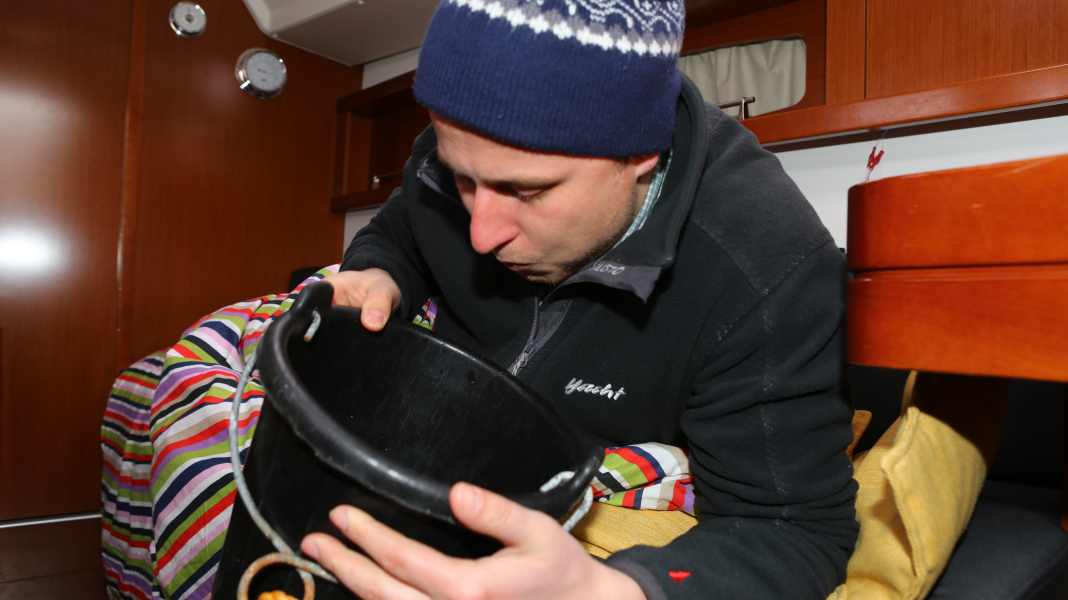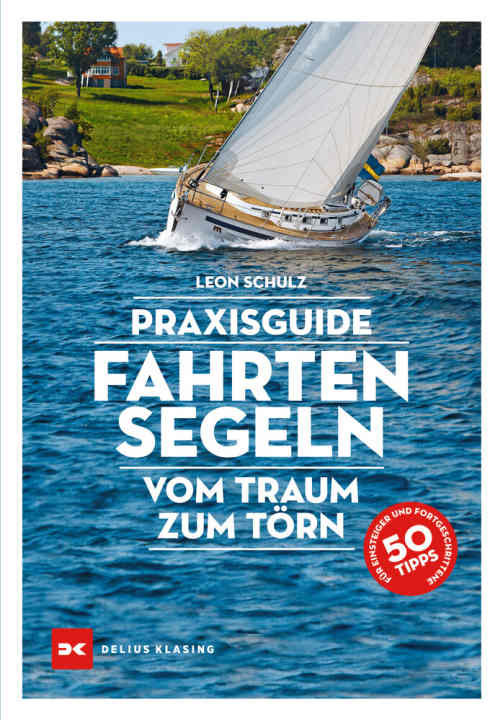
It's a myth that real sailors never get sick. Almost everyone gets sick, some even in moderate conditions, others only when the going gets really tough. But the following always applies: good seamanship means not keeping quiet about your own discomfort or that of a fellow sailor, but instead openly addressing the problem - and then actively taking action against it.
YACHT author Leon Schulz. As a professional skipper and RYA Yachtmaster Ocean Instructor, he has been sailing for years with his Hallberg-Rassy 46 "Regina Laska" on a variety of charter and training trips in the Atlantic, North Sea and Baltic Sea. He is familiar with the problem of seasickness and says that there are a number of helpful strategies to combat it - so as not to spoil the fun of sailing in the truest sense of the word. They are reflected in the following eight questions and answers.
Question 1: If I am prone to seasickness, can I sail at all?
Answer: Seasickness comes in two phases, as experienced sailors joke: "In the first phase, you're afraid of dying. In the second phase, you're afraid you won't die!" But seriously: the topic of seasickness should be addressed openly in the crew briefing before the trip. It's important to talk about prevention, symptoms and treatment. Most people suffer from seasickness, and many are embarrassed by it. Dealing with the problem openly helps to avoid feeling like a landlubber unfit for sea or an outsider. The good news first: seasickness usually decreases with age, and on average you get used to being rocked by waves within three days, you get sea legs.
Most people are prone to seasickness, even if they don't want to admit it. Some may claim that they have never been seasick. But the statistics speak for themselves: only around ten to 15 per cent of people do not get seasick at all, and a group of people of roughly the same size do not even get seasickness under control after several days at sea. Nevertheless, 85 to 90 per cent of people can do something about their seasickness, especially if personal symptoms are noticed early and action is taken quickly. Seasickness should not be underestimated and can have a negative impact on safety on board.
Question 2: Can I somehow get used to the movements before the cruise?
Answer:Swapping the office chair for the bunk on board at the start of a sailing trip, stressed and exhausted, and wanting to set sail immediately with a great urge to clock up the miles is not exactly an ideal approach. Stress makes the entire organism susceptible to disturbances, and the susceptibility to anxiety and seasickness is significantly increased. It is therefore very helpful to spend a day or two in the harbour, slowly stow away your luggage and provisions and gradually reduce your stress levels. This allows you to enjoy your stay on board your ship and get used to the small wave movements in the harbour in an increasingly relaxed manner.
It is advisable to plan the first beat on a fine day without unpleasant waves, i.e. to have current and wind in the same direction and, if possible, to sail in sunshine. Many people get less seasick in the sun than when it is wet, cold and cloudy.
Once you have finally got your sea legs, you can probably gradually tolerate bigger and bigger waves and rocking movements - without feeling any impairment to your well-being. Unfortunately, the sea legs disappear again relatively quickly: after about 14 days of abstinence from the rocking sea, the annoying game starts all over again.
Question 3: What can I do against seasickness before the cruise?
Answer: Having body and soul in harmony is a good basic requirement. Other helpful preparation options are: not eating too greasy a meal shortly before the trip, not having a full or hungry, empty stomach, no residual alcohol from the evening before and not drinking too much coffee or tea. Some people find high doses of vitamin C (1000 milligrams per day at least one week before the cruise) helpful in order to benefit from its histamine-reducing effect.
In addition, the body doesn't want to be too cold or too hot, which means that the right clothing is just as important. A good night's sleep with restful sleep is also helpful. Psychologically, it is important that you feel comfortable with the upcoming situation, the weather, the trip, the ship and the crew and that you are not anxious yourself. Sailing experience also helps against seasickness. Newcomers are often more likely to get seasick than experienced sailors, who are psychologically more comfortable with sailing.
Anxiety and seasickness are closely linked, as there are interactions between them. Anxiety can directly trigger and/or exacerbate seasickness and vice versa. Accordingly, a respectful and understanding atmosphere on board helps to minimise both problems. Unfortunately, seasickness at least can often not be completely prevented.
You can also take seasickness medication before setting sail. They are probably the most reliable method of preventing the nausea. Some medicines require a lead time of several hours before they have the desired effect, for example scopolamine. They should therefore be taken in good time.
Question 4: What medication can I take for seasickness?
Answer:There is a wide range of modern and extremely effective medication for seasickness. Incidentally, they are also available in every well-equipped life raft and should be taken immediately in an emergency.
But even without an emergency, various medications can be tried out and taken beforehand in consultation with your family doctor. It is best to test the medication of choice on land first to check for possible side effects. Prescription drugs include cinnarizine (under the product names Stugeron, Stunarone, Arlevert, Dizinil 25) and scopolamine (as a plaster behind the ear under the product name Scopoderm). Not all medications are available in all countries, so it is worth asking in neighbouring countries. In any case, your own doctor should be consulted before experimenting with medication.
Some people are afraid of the potential side effects of seasickness medication. However, you should also consider the potentially dangerous effects of seasickness itself. Seasickness can be quite dangerous: from dehydration, to passivity on board when the boat and crew are in danger, to suicidal thoughts. Severe seasickness should not be underestimated and medication can help effectively.
Question 5: How can I prevent seasickness during the cruise?
Answer:Some typical triggers of seasickness should be prudently avoided. Staying below deck for a long time, for example, quickly triggers nausea, especially when getting dressed upside down or searching for stowed luggage. Prudent sailors are either active in the cockpit in the fresh air or lie in their bunk with their eyes closed. The distance between cockpit and bunk is travelled at lightning speed.
Going to the toilet often proves to be problematic. However, drinking less for this reason is counterproductive: dehydration is anything but good when sailing. Going to the toilet should be done in such a way that you can get from the safety of the cockpit to the wet room and back again as quickly as possible. If you have no inhibitions, you can get rid of essential items of clothing in the cockpit, scurry down quickly and later ask a fellow sailor to pump the toilet for you. Alternatively, you can use the famous MuFuEi (multifunctional bucket) to relieve yourself outside in the fresh air. However, you should never pee overboard, as all too many people have drowned with their trousers down.
Reading and cooking below deck are also triggers for seasickness, especially if the food is accompanied by strong odours and herbs. The best thing to do during the first few days in harbour is to briefly heat up prepared food with a few herbs or simply eat biscuits, fruit or sandwiches on shorter trips.
Question 6: What are the characteristic symptoms?
Answer: Experienced sailors realise early on when things are starting to slow down and know their body well enough to take immediate countermeasures. Then you need to act quickly: get out into the fresh air, take the helm and sail actively or watch the horizon. With luck, this will counteract seasickness quickly enough.
Everyone should get to know their own symptoms - that is also gaining sailing experience. Typical signs of seasickness are tiredness, passivity and cold sweat. If a crew member is yawning and hiding downwind behind the sprayhood to count the hours to harbour, the attentive skipper needs to inconspicuously activate the person and do something about their seasickness.
Question 7: How can the ship's movements be made more pleasant during the cruise?
Answer: Not all waves are the same, and a change of course can also work wonders during the trip. There are studies that show that seasickness is triggered more when the boat pitches - the boat rocks forwards and backwards - than when it rolls - the boat rocks from port to starboard. This is in line with the experience that more people get seasick when sailing against the wind (hard on the wind) than when sailing on a beam reach, i.e. with wind from behind. It is therefore experienced as more pleasant when the wind and waves roll in from astern and slowly move the boat from one side to the other than when the boat is pitching against the wind and waves.
A change of course to the centre of the course not only turns initially pounding waves into rolling ones, but the waves also become pleasantly longer. If you fight against the wind, you are practically sailing against the waves, which means that the relative frequency of the waves is high. If, instead, you are sailing on the beam, the boat and the waves are travelling in roughly the same direction and the waves no longer roll under the boat as often. Keeping the boat's own speed as high as possible not only helps to further reduce the number of waves per unit of time, but also to ensure that the keel remains stable. Especially for boats with a short keel, fast sailing is much more pleasant than bobbing around.
Question 8: What can I do to combat seasickness if it has affected me?
Answer: If the nausea is already present, the road back to freedom from symptoms is long and often only occurs after a good night's sleep, unless there is land and calm waters nearby to save the day. Some sailors know their bodies very well, see their own seasickness at the start of the season as a necessary evil and accept it with radical acceptance or largely take it in their stride. They reach for an empty yoghurt bucket and quickly throw up in it. Then he takes a sip of water and the spook is over - until the next time. However, not all sailors are granted this relaxed approach to the illness. Important and valid for everyone: vomiting over the railing should be forbidden. The risk of falling overboard is simply too high.
In addition to fresh air and active sailing at the helm, many people also find it helpful to listen to music they like on the cockpit speakers. This provides a distraction, puts you in a good mood and motivates you to sing along. Breathing automatically while singing can often effectively counteract nausea. If you don't believe it, just try it! Singing really does help.
If the trip is not over within a few hours, it is essential to drink enough water. As soon as you have happily arrived back in harbour after experiencing seasickness, salts (Dioralyte) help to rebalance your electrolytes.
Continue reading here:
10 tips against seasickness
Literature tip:

In his new "Practical guide to cruising" (click here to order!) Leon Schulz not only addresses the topic of seasickness in detail. The 336-page work (Delius Klasing, 24.90 euros) is divided into five main chapters: "The sailing area", "The cruising boat", "Safety and emergency equipment", "Before setting off" and "The cruise". In each chapter, the author addresses the most important aspects of cruising sailing, allowing beginners in particular quick and easy access to the respective topic.


